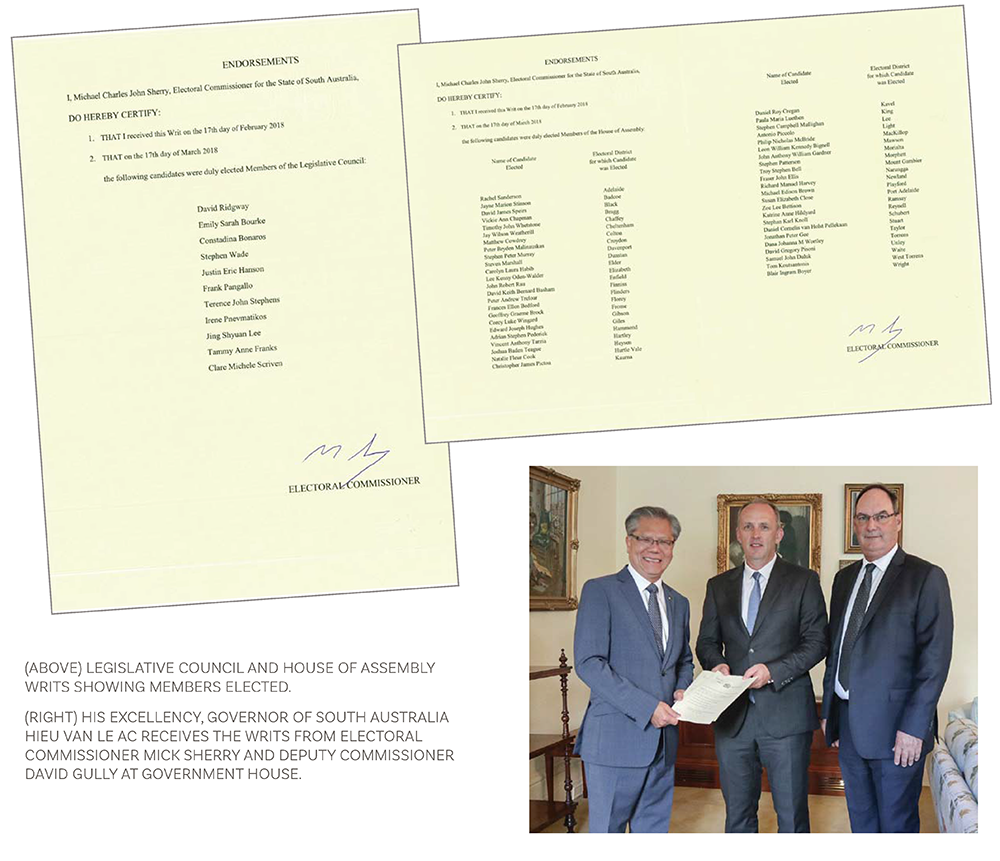INTRODUCTION
Before staff can head home after their full-day shifts, almost 1.6 million ordinary ballot papers need to be scrutinised and counted with the results entered into ECSA’s systems and transmitted to our website and the media.
In the busy days that follow, the rolls from each polling booth must be scanned before the nearly 300,000 declaration envelopes can be scrutinised and – if accepted – opened by Returning Offi cers and the ballot papers they contain added to the count. This, along with rechecks and other counts, continues while postal votes return until the results can be finalised seven days after polling day.
Meanwhile, the Legislative Council recheck count takes much longer, with nearly half a million ballot papers needing to be securely transferred to the scanning centre. Once there, they are scanned and data-entered after which data from all votes is processed through the counting software, with preferences distributed and the results declared.
In all, nearly 2.2 million ballot papers must be securely stored, counted, checked and then transferred for safe storage in these busy weeks. ECSA staff work tirelessly to ensure the accuracy of the result, observed throughout by scrutineers who ensure the transparency of the process at polling booths, Returning Officers’ premises, the central processing centre, LC counting centre and scanning centre.
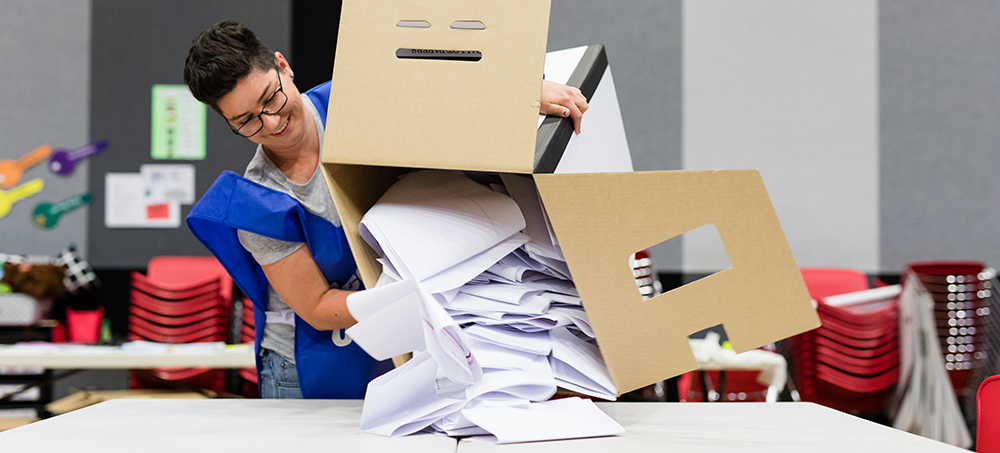
COUNTING ON ELECTION NIGHT
The counting of votes began soon after polling booths closed at 6pm. Polling Officials conducted three separate counts of the ordinary votes issued at their booth on polling day:
- a first preference count of House of Assembly ballot papers
- a Two-Candidate Preferred count of House of Assembly ballot papers
- a first preference count of Legislative Council ballot papers
After the first preference votes of House of Assembly ballot papers had been counted, a Two-Candidate Preferred count was undertaken with preferences distributed to the two candidates considered most likely to be in the lead. This count provided an early indication of the election results and a snapshot of preference flows for political parties and the media. At some polling booths, staff worked late into Saturday night to ensure all ordinary votes were counted.
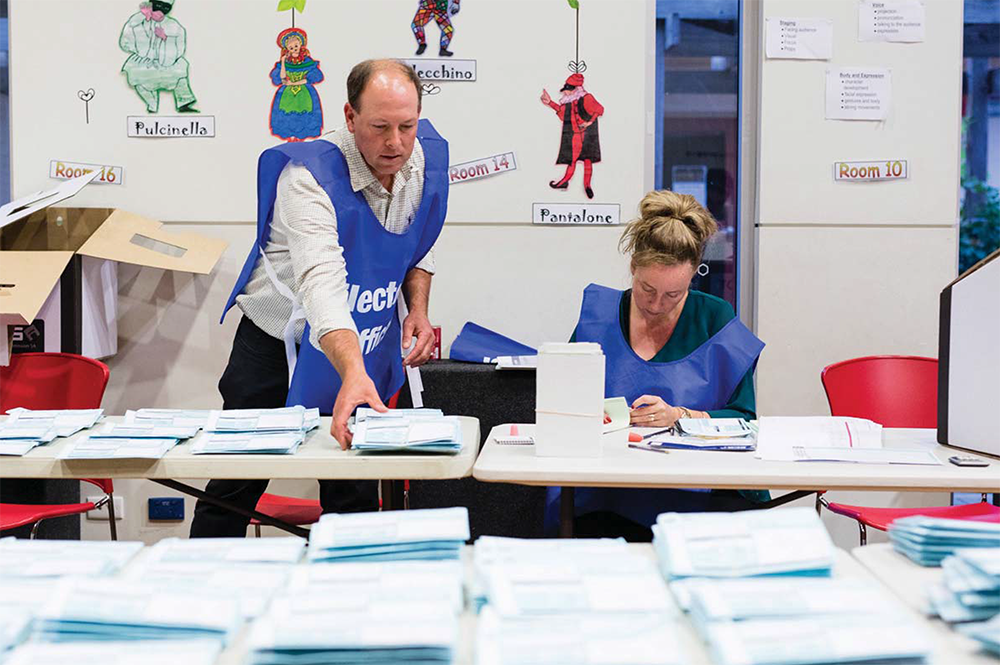
RECHECKS AND TWO-PARTY PREFERRED COUNTS
On the Sunday after polling day, Returning Officers conducted a recheck and recount of all ordinary House of Assembly ballot papers for all booths, including an assessment of informal and undetermined ballot papers to see if they followed candidates’ voting tickets.This was followed by Two-Party Preferred (2PP) counts for each polling booth to show how the vote was divided between the Labor and Liberal parties, taking into account the preferences of people who had voted for other parties and independents. A 2PP count was also performed on the following Saturday on all declaration votes admitted into the count.
ROLL SCANNING
After polling booths closed, the electoral rolls which Polling Officials had used to mark off voters’ names were collected by Returning Officers and transferred to the scanning centre where they were scanned district by district beginning late on election night. Over the next two-and-a-half days all rolls were scanned and the contents converted into data to provide ECSA with an accurate list of who had voted and who appeared not to have voted.Polling booth rolls from the 20 districts deemed to be marginal were couriered to the scanning centre and processed urgently. The rolls from the remaining non-marginal districts were delivered and scanned subsequently, with all scanning and processing of around 1,800 rolls completed on schedule by noon on Tuesday 20 March.
As soon as the roll data was available for their district, each Returning Officer and their staff could begin the processing and counting of the thousands of postal, absent and pre-poll declaration votes.
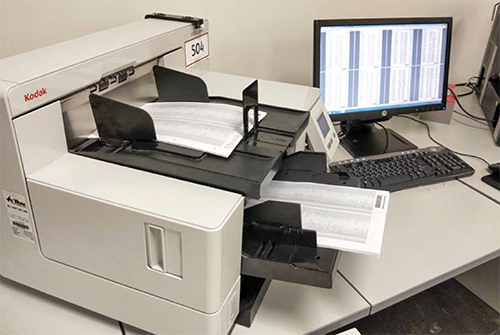
DECLARATION VOTE COUNT
Over the week following polling day, Returning Officers processed the declaration votes received in their districts.Each declaration vote envelope needed to be scrutinised before being opened to ensure that the votes cast were admissible to the count and to reduce the risk of multiple voting. After setting aside any rejected envelopes, staff removed the declaration flaps from the accepted envelopes before opening them and counting the ballot papers. The counts were conducted in the same manner as the ordinary ballot paper recheck counts.
Because postal votes could be received up to seven days after polling day, the final declaration vote count was not held until Saturday 24 March.
A CALL FOR LEGISLATIVE CHANGE: COUNTING ORDINARY PRE-POLL VOTES ON POLLING DAY
As the number of declaration votes cast at pre-poll centres increases at state elections, the counting process becomes more drawn out, and the more likely it becomes that results in close elections remain unknown for several days. ECSA recognises that a situation could arise in a close election with a large number of declaration votes where South Australians might have to wait for a week after polling day to know the outcome of the election due to the extra time needed for the count.The current declaration vote scrutiny process cannot take place until the week after polling day once the rolls have been scanned and declaration envelopes delivered to each Returning Officer. A number of jurisdictions – the ACT, the Commonwealth, New Zealand, NT, Tasmania and Victoria - have resolved this problem by issuing the majority of pre-poll votes as ordinary votes and then counting these on polling day. ECSA recommends this approach be adopted in South Australia and seeks legislative change to do so.
As discussed in the 'Call for legislative change: Issuing ordinary votes at pre-poll centres' (click here to read more), if ECSA is permitted to issue ordinary votes at pre-poll centres to electors from the electoral district where the centre is located, this will ensure that most pre-poll votes are ordinary votes and can be counted sooner.
Following the New Zealand model, on the evening prior to polling day these ordinary votes cast would be transferred to the central processing centre, where they would be counted on polling day in a restricted area under tight security conditions to guarantee the secrecy of the count until after polls close. This would result in a much larger number of votes being included in the results reported on election night and provide the public with greater knowledge of the outcome of the election that same night. The resultant smaller number of pre-poll votes issued as declaration votes would be scrutinised as usual in the week after polling day to ensure their validity before their inclusion in the count.
That the Act be amended to allow the scrutiny to commence before the close of polling so that ordinary votes cast at pre-poll voting centres (if Recommendation 13 is taken up by Parliament) can be scrutinised and counted on polling day under suitably tight security conditions to guarantee the secrecy of the count until after the close of poll.
SPOTLIGHT : THE COMPLEXITY OF THE LEGISLATIVE COUNCIL COUNT
The counting and processing of results for the Legislative Council (LC) election is always a complex undertaking. The single transferable vote system used for the election, the large numbers of candidates with preferences to distribute, along with the choice of two voting options on the ballot paper invariably make for a laborious process. In 2018, things were complicated further by the change to voting in the LC election and the much greater than expected volume of ballot papers with multiple preferences requiring scanning and data entry.
At polling booths on election night, Polling Officials conducted a first preference count of the LC ordinary votes. Over the next two days, ordinary ballot papers were transferred securely from polling booths around the state to ECSA’s LC counting centre where they were manually rechecked and recounted, district by district, by a team of 75 staff. Ballot papers with a single group preference marked above the line were totalled (almost 634,837, or 58% of all ballot papers) and stored for loading into the counting system. All ballot papers marked below the line, or with multiple preferences above the line, as well as any ballot papers where there was any confusion about the voter’s intentions were batched and then transferred securely to the scanning centre.

The 2018 Election saw an eleven-fold rise in the number of ballot papers that were too complex for manual counting. Whereas at previous elections, data entry was used to count ballots marked below the line, in 2018 the sheer volume of ballot papers with multiple preferences and the impracticality of data entering so many necessitated the use of scanning. In all, the scanning centre processed 350,697 ballot papers with multiple preferences above the line (32% of all ballot papers), 65,202 ballot papers marked below the line (6.0%), and 44,635 ballot papers initially assessed as informal (4.1%). By comparison, in 2014 there were just 41,234 ballot papers marked below the line or informal that required data entry (4.1% of all ballot papers). This surge in numbers extended the period it took to process the results to five weeks.
After checking and confirming the total figures for every polling place and declaration count, ECSA staff loaded the details of every batch of ballot papers into the EasyCount counting system. On 23 April, 37 days after polling day, the Returning Officer for the LC ran the EasyCount software and conducted the declaration of the poll to announce the 11 successful candidates.
EasyCount software has been provided by the AEC under licence for each LC election since 1997. ECSA acknowledges the AEC’s support in managing the complexities of a computer count of the size of an LC election. However, the AEC has advised it intends to discontinue development and support for EasyCount, which will require an alternative solution for future LC elections. Considerable costs will be incurred in sourcing or developing an appropriate replacement system.
SPOTLIGHT : LEGISLATIVE COUNCIL RETURNING OFFICER TREVOR OVERY
At that time, polling booth managers were given a global budget to hire their own staff, train and supervise them, pay them, and prepare and send out their staff group certificates.
Trevor worked as a polling booth manager for every state election after that until a sudden vacancy a few weeks short of the 1989 election saw him drafted as RO for the Albert Park district.
“They threw me in at the deep end; I hadn’t had much training, but we got there, and I learned quickly. We ran the election out of my loungeroom and employed about 120 staff, we had a budget of about $25,000 to run ten booths.”
At the next few elections he was RO for the district of Adelaide which, Trevor says, was harder work given the number of declared institutions – the RAH, Wakefield St Hospital, St Andrews Hospital and the Remand Centre – requiring electoral visits.
This year’s State Election marked his fourth as RO for the Legislative Council, possibly his last election, “I need an understudy to take over from me,” Trevor says.
Being the sole RO for the Legislative Council is much more labour intensive, Trevor says, given the number of candidates, particularly the plethora of minor parties and independents when compared to a House of Assembly district which may have only four candidates.
A career public servant who is now retired, Trevor says he’s enjoyed immensely his time working on elections and is a Deputy Returning Officer for Adelaide City Council at the 2018 council elections. While reluctant to commit to another election he says he would consider working as an assistant next time.
“It’s good work, besides I love the camaraderie and the friendships you make over the years, it’s definitely a labour of love,” he says.

RESULTS CAPTURE AND REPORTING
On election night, polling booth managers relayed
the results of their polling booth count to their ROs,
who checked and entered them into the Results
Entry Module (REM) computer system. Monitoring of
results processing was managed centrally by ECSA
to assist in identifying delays in results or possible
discrepancies.
Over the following days, the results for polling
booth rechecks, 2PP and declaration vote counts
were entered by ROs as they were undertaken, until
the final declaration count later that week. Final
results were updated following the distribution of
preferences conducted on the second Sunday after
polling day.
At no time are ECSA’s ICT systems more important
than on election night, when the results are entered
into the system and transmitted to the ECSA
website and the media. To ensure a reliable election
night experience for South Australians, considerable
testing and redundancies were built into the results
applications, including conducting two full result
entry trials in the week before polling day, to load
test and check the operation and accuracy of the
system. In one of these tests, all 47 ROs and their
staff undertook a dry run entering the full election
night results from the 2014 State Election into the
system. In this way, staff were trained and practiced
in entering data for each of the three election night
counts and ECSA’s technology was ready to go,
working flawlessly on election night without any
website or application outages.
RESULTS DISSEMINATION
ECSA again provided a live stream of the 2018
election results to the ECSA website to allow the
public to view real-time results. Results from the
REM system automatically updated onto the
ECSA website and were made available as a direct
feed to media from the close of voting at 6pm on
election night until counting was completed the
following weekend. Television networks and media
organisations used the direct data feeds of results to
support their election reports and broadcasts.
The process of reporting results went smoothly, with
no outages or technical difficulties, even with ECSA
website receiving more than 400,000 hits on the
afternoon and evening of polling day.
Final House of Assembly results were published
on ECSA’s website for all districts following the
distribution of preference counts on Sunday
25 March. Final results for the Legislative Council
were published after the declaration of the poll on
Monday 23 April.
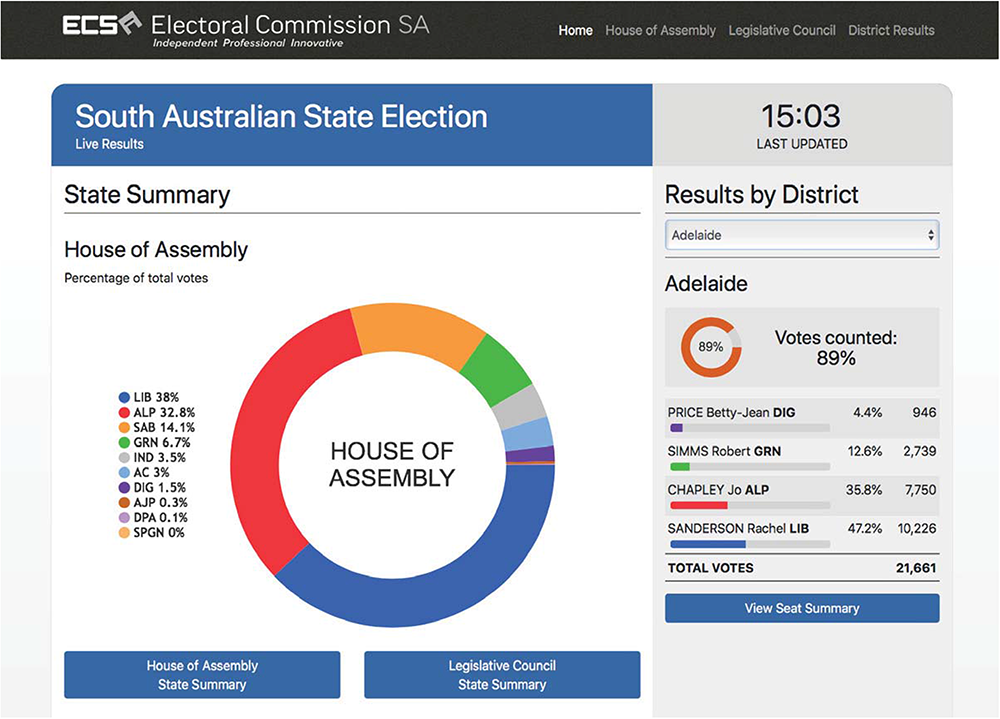
TICKET VOTING
Amendments to the Act in 2017 removed ticket voting for the Legislative Council.Ticket voting for the House of Assembly is one of the unique features of South Australian elections. Because voters must indicate preferences for all candidates on the ballot paper if they wish their vote to be counted, there is potential for a high number of informal ballots. Voting tickets lodged by candidates serve as a ‘savings provision’ for votes that would otherwise be informal.
House of Assembly ballot papers marked with a single 1, ü(tick) or û (cross), or partially completed with consecutive preferences consistent with a voting ticket lodged by the party, candidate or group, are accepted as formal ballot papers and attributed to the candidate for whom the first preference is marked.
Ticket voting for the House of Assembly in 2018 represented 3.8% of all formal ballot papers, an increase from 3.6% in 2014. Eight candidates (3%) did not lodge a voting ticket for the 2018 Election compared to 2014 when three candidates (1.5%) chose not to lodge a voting ticket. The highest rate of ticket voting was 7.7% in the district of Bragg with the lowest rate of 2.1% being recorded in Kavel.
INFORMALITY
Informality, at 4.1% for both the Legislative Council and House of Assembly elections, while comparatively low for the Legislative Council was uncharacteristically high for the House of Assembly.In the Legislative Council election, the increase was only slight, up from 3.9% in 2014. However, this rise came in spite of the number of candidates dropping from 63 in 2014 to 43 in 2018, and a change in the formality rules for below-the-line voting whereby voters only needed to complete 12 preferences below the line (with a savings provision of six), compared to the previous requirement to mark all candidates.
Informality in the House of Assembly election increased by one percentage point, up from 3.1% in 2014. Although some of the increase may reflect voter confusion at the higher number of candidates contesting the elections, ECSA’s post-election analysis of the informal ballot papers suggests the majority of informal votes were intentionally informal (see ballot paper audit section, Read more).
ECSA is concerned about these increases in informality and recognises that work is needed to reduce informality at future elections. Dedicated measures to tackle informality over the next election cycle may include the proposed voter education program in schools and multicultural community centres, consideration of improved instructions on ballot papers, and an expansion of the Community Ambassador program (Read more).
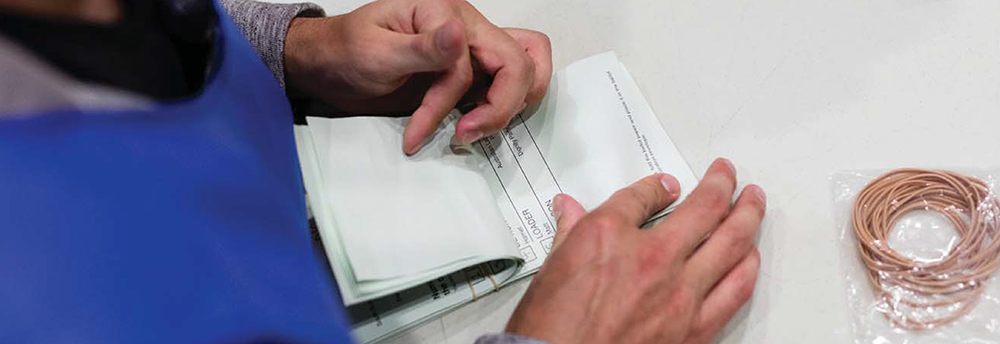
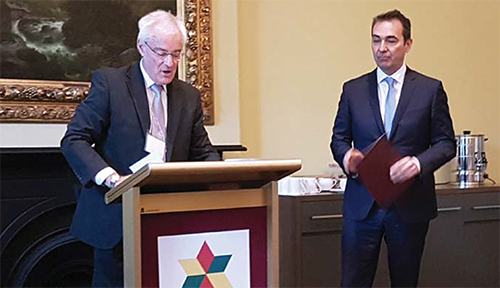
DECLARATION OF RESULTS
The results for the 47 districts of the House of Assembly were declared during the week of 26 March while the declaration of the results for the Legislative Council was conducted on 23 April.RETURN OF THE WRITS
The writs were returned to the Governor of South Australia, His Excellency Hieu Van Le AC, on 26 April 2018 at Government House.